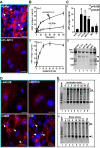von Willebrand factor cleaved from endothelial cells by ADAMTS13 remains ultralarge in size
- PMID: 19682236
- PMCID: PMC2755043
- DOI: 10.1111/j.1538-7836.2009.03570.x
von Willebrand factor cleaved from endothelial cells by ADAMTS13 remains ultralarge in size
Figures

References
-
- Padilla A, Moake JL, Bernardo A, Ball C, Wang Y, Arya M, Nolasco L, Turner N, Berndt MC, Anvari B, Lopez JA, Dong JF. P-selectin anchors newly released ultra-large von Willebrand factor multimers to the endothelial cell surface. Blood. 2004;103:2150–6. - PubMed
-
- Sadler JE. von Willebrand factor: two sides of a coin. J Thromb Haemost. 2005;3:1702–1709. - PubMed
-
- Dong JF, Moake JL, Nolasco L, Bernardo A, Arceneaux W, Shrimpton CN, Schade AJ, McIntire LV, Fujikawa K, Lopez JA. ADAMTS-13 rapidly cleaves newly secreted ultralarge von Willebrand factor multimers on the endothelial surface under flowing conditions. Blood. 2002;100:4033–9. - PubMed
Publication types
MeSH terms
Substances
Grants and funding
LinkOut - more resources
Full Text Sources

